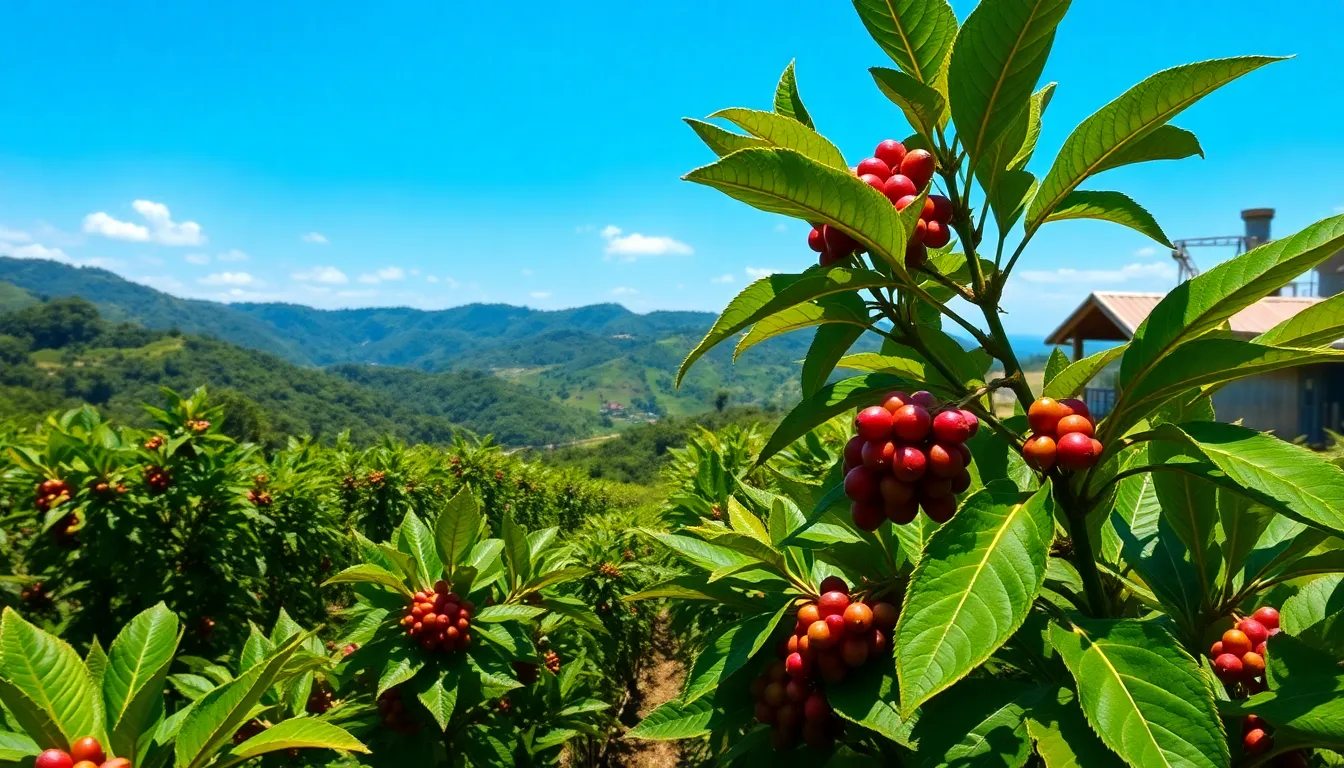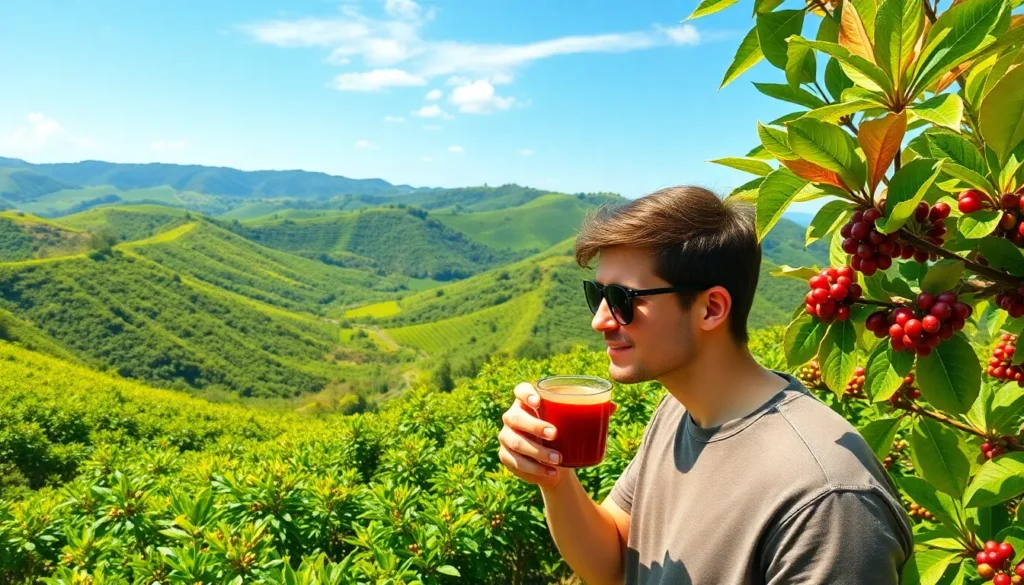Table of Contents
ToggleCoffee lovers, rejoice! The world of coffee isn’t just a delightful brew; it’s a thrilling adventure through lush landscapes and diverse cultures. Picture this: sipping a freshly brewed cup while soaking in the breathtaking views of Colombia’s rolling hills or the vibrant farms of Ethiopia. Each coffee region boasts its own unique flavor profile, influenced by everything from altitude to local traditions.
Overview of Coffee Regions
Coffee regions represent the heart of the coffee production process. Each region cultivates unique coffee beans that exhibit distinct flavors influenced by environmental conditions and farming methods.
Colombia is known for its rich, aromatic coffees, often produced at high altitudes. Elevation contributes to the bright acidity and sweet flavor profile found in Colombian beans. Ethiopia stands out with its diverse varieties, showcasing floral and fruity notes, thanks to its rich heritage of coffee cultivation.
Central America, including countries like Costa Rica and Guatemala, offers beans with vibrant acidity and chocolate undertones. Soil composition and climate play crucial roles in developing these tastes.
In South America, Brazil produces a significant portion of the world’s coffee. Its beans often feature nutty, chocolatey flavors, driven by the flat topography and extensive plantations.
Africa’s diverse coffee regions, such as Kenya and Tanzania, yield some of the most prized beans globally. Kenyan coffees are celebrated for their bold acidity and berry flavors, while Tanzanian varieties often include wine-like nuances.
Asian coffee regions, particularly Vietnam and Indonesia, contribute unique flavor profiles. Vietnamese coffee often has a deep, earthy taste, while Indonesian beans are known for their full body and low acidity.
Understanding these regions and their characteristics empowers coffee enthusiasts to appreciate the complexity found in every cup. Recognizing the nuances of each growing area enhances the overall coffee experience, connecting consumers to the origins of their favorite brews.
Major Coffee Producing Regions

Coffee thrives in various regions around the world, each contributing unique flavors and characteristics to the beans. Understanding these regions enhances the appreciation of coffee and its origins.
Central and South America
Central and South America are home to prominent coffee producers. Colombia stands out for its rich and aromatic coffees that exhibit bright acidity. Costa Rica produces well-balanced beans with vibrant acidity and fruity notes, while Guatemala is known for chocolate undertones and rich flavors. Brazil contributes nutty and chocolatey profiles, making it a significant player in the coffee market. These countries benefit from ideal altitudes and climates that allow coffee plants to flourish, resulting in distinctive taste experiences.
Africa
Africa is renowned for its diverse coffee varieties and bold flavors. Ethiopia is often referred to as the birthplace of coffee, offering beans with floral and fruity notes. Kenya produces highly sought-after coffees that feature bright acidity and berry flavors, captivating consumers around the globe. Tanzania’s Arabica beans also carry enticing citrus undertones and balanced acidity. Many African coffee-growing regions experience unique microclimates that enhance flavor profiles, contributing significantly to the global coffee scene.
Asia and Pacific
Asia and the Pacific regions deliver deep, earthy tastes and full-bodied profiles. Vietnam is a leading producer, primarily growing Robusta beans valued for their strong and robust flavor. Indonesia, particularly Sumatra, is known for its rich, full-bodied coffees with herbal and spicy notes. The Philippines also contributes with unique beans offering bright acidity and fruity hints. Various altitudes and distinct farming methods across these regions play pivotal roles in shaping the unique characteristics of their coffee.
Coffee Varieties by Region
Coffee varieties differ significantly, reflecting the unique characteristics of their growing regions. Understanding these varieties enhances appreciation for the diverse flavors found in coffee.
Arabica vs. Robusta
Arabica and Robusta represent the two primary coffee species cultivated globally. Arabica beans account for about 60-70% of global coffee production, thriving in higher altitudes and cooler climates. They typically have a smoother flavor with significant acidity. Robusta beans, comprising around 30-40% of production, grow at lower altitudes, featuring a stronger taste and higher caffeine content. This species often contributes to a more bitter profile, helping to create a rich crema in espresso. Their resilience to diseases allows for easier cultivation, especially in hot, less desirable environments.
Unique Flavor Profiles
Distinct flavor profiles emerge from each coffee-growing region due to varying environmental conditions. Colombian coffees exhibit a balance of acidity and sweetness, frequently presenting caramel and nutty notes. Ethiopian varieties showcase vibrant floral and fruit flavors, often with hints of berries and jasmine. Central American beans, such as those from Costa Rica and Guatemala, frequently highlight bright acidity and chocolate undertones. Brazil provides nutty, chocolatey coffees, while African regions like Kenya and Tanzania produce beans with bold acidity and berry nuances. Asian coffees, particularly from Vietnam and Indonesia, adopt deep, earthy notes characterized by full-bodied profiles.
Impact of Geography on Coffee Quality
Geography plays a crucial role in shaping the quality of coffee on a global scale. Factors like altitude, climate, and soil composition significantly influence the characteristics of coffee beans.
Altitude and Climate
Altitude directly correlates with the quality and flavor of coffee. Higher elevations, commonly found in regions like Colombia and Ethiopia, provide cooler temperatures that slow the cherry maturation process, enhancing sweetness and acidity. Central American countries like Costa Rica and Guatemala also benefit from elevated terrains, producing beans with bright, vibrant notes. Furthermore, microclimates, such as those in Kenya and Tanzania, create unique environments that foster distinctly flavored coffees. Variations in rainfall, temperature, and sunlight at different altitudes lead to diverse flavor profiles, enriching the global coffee landscape.
Soil Composition
Soil composition significantly affects coffee flavor development. Nutrient-rich volcanic soils in areas like Colombia contribute to the complex sugary profiles found in their beans. In contrast, sandy soils common in Brazil can produce coffees with nutty, chocolatey notes. The mineral content and organic matter in the soil provide essential nutrients to the coffee plants, impacting taste and body. Regions with diverse soil types, such as Ethiopia and Costa Rica, reveal how geology influences flavor complexity. Healthy soil promotes better root systems, allowing coffee trees to absorb vital minerals, ultimately reflecting in the cup.
Future Trends in Coffee Regions
Emerging trends in coffee regions reveal vital shifts in production practices and environmental responses. The coffee industry adapts to evolving challenges and consumer demands, focusing on sustainable methods.
Sustainable Farming Practices
Sustainable farming practices are gaining traction across coffee regions. Organic cultivation methods reduce chemical use, promoting biodiversity and soil health. Many growers implement shade-grown techniques, allowing coffee plants to thrive under canopy trees. Certification programs, such as Fair Trade and Rainforest Alliance, encourage ethical practices, aiding farmers in achieving better prices. Increased consumer interest in ethically sourced coffee drives these changes, influencing worldwide purchasing habits. Transitioning to sustainable practices often leads to higher quality beans, creating a win-win situation for both producers and consumers.
Climate Change Effects
Climate change significantly impacts coffee regions globally. Rising temperatures and shifting rainfall patterns threaten traditional coffee-growing areas. Some regions experience increased pest and disease prevalence, undermining future yields. Adaptive strategies emerge as vital for maintaining production levels. Many farmers consider diversifying crop varieties to enhance resilience against climatic challenges. Exploring altitudes and microclimates becomes crucial to finding suitable growing conditions. Enhanced research focuses on developing climate-resistant coffee plants, aiming to protect the livelihoods of millions dependent on coffee cultivation.
The world of coffee is a vibrant tapestry woven from diverse regions and unique flavors. Each cup tells a story shaped by its origin and the meticulous care of growers. As consumers become more conscious of where their coffee comes from they’re not just savoring the taste but also connecting with the rich traditions and sustainable practices behind it.
The future of coffee relies on adaptive strategies to combat climate change and promote ethical sourcing. By supporting sustainable farming practices and embracing the distinct characteristics of each region coffee lovers can enjoy a deeper appreciation for their favorite brews while contributing to a more resilient global coffee community.




